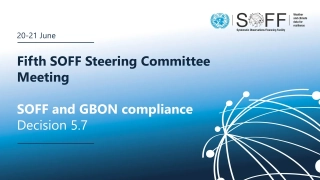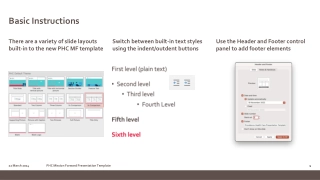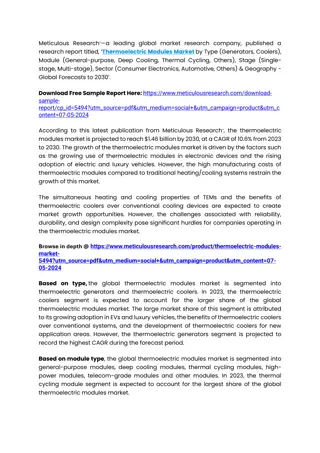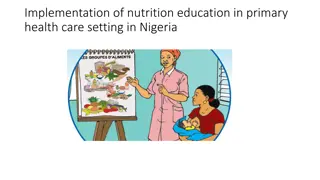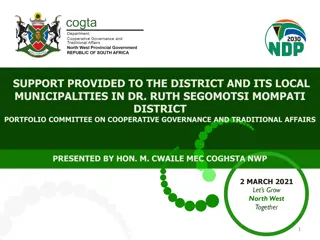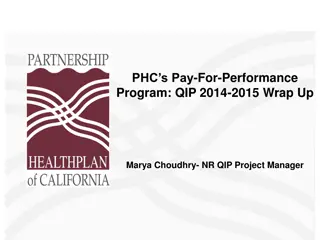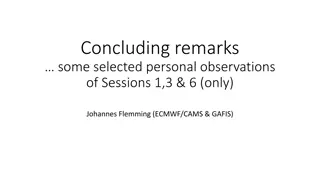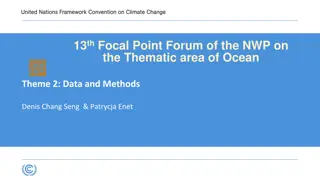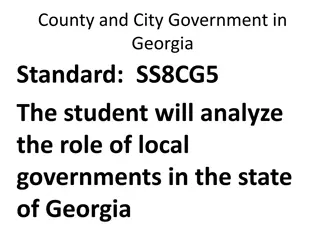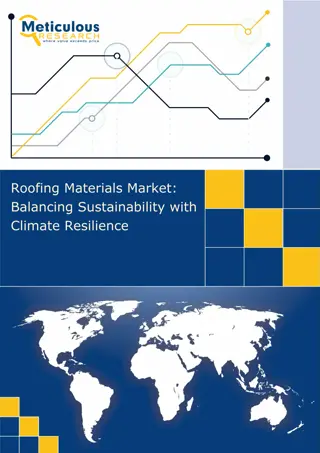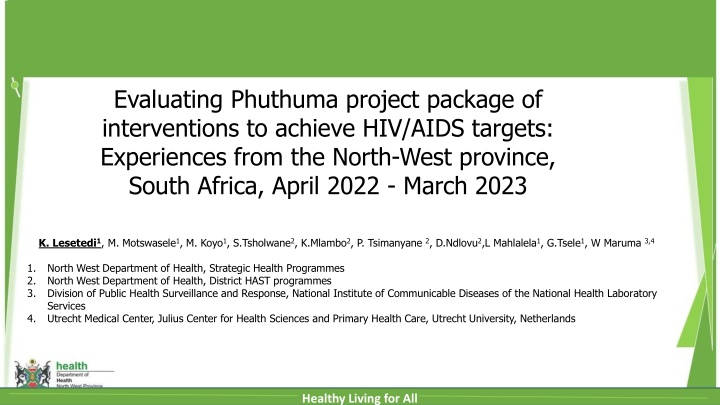
Evaluating Phuthuma Project Interventions for HIV/AIDS Targets in North-West Province
Explore the evaluation of the Phuthuma project interventions aimed at achieving HIV/AIDS targets in South Africa's North-West province from April 2022 to March 2023. The study delves into the background, problem statement, aims, methods, results, and lessons learned, providing valuable insights into combating the epidemic.
Download Presentation

Please find below an Image/Link to download the presentation.
The content on the website is provided AS IS for your information and personal use only. It may not be sold, licensed, or shared on other websites without obtaining consent from the author. If you encounter any issues during the download, it is possible that the publisher has removed the file from their server.
You are allowed to download the files provided on this website for personal or commercial use, subject to the condition that they are used lawfully. All files are the property of their respective owners.
The content on the website is provided AS IS for your information and personal use only. It may not be sold, licensed, or shared on other websites without obtaining consent from the author.
E N D
Presentation Transcript
Evaluating Phuthuma project package of interventions to achieve HIV/AIDS targets: Experiences from the North-West province, South Africa, April 2022 - March 2023 K. Lesetedi1, M. Motswasele1, M. Koyo1, S.Tsholwane2, K.Mlambo2, P. Tsimanyane 2, D.Ndlovu2,L Mahlalela1, G.Tsele1, W Maruma 3,4 1. 2. 3. North West Department of Health, Strategic Health Programmes North West Department of Health, District HAST programmes Division of Public Health Surveillance and Response, National Institute of Communicable Diseases of the National Health Laboratory Services Utrecht Medical Center, Julius Center for Health Sciences and Primary Health Care, Utrecht University, Netherlands 4. Healthy Living for All
Presentation Outline Background Problem Statement Aims and Objectives Methods Interpretations Results Lessons Learned Limitations Acknowledgements
Background In 2014, the country adopted the Joint United Nations Programme on HIV/AIDS (UNAIDS) 90-90-90 set targets (90% of people living with HIV should know their status, 90% who know their HIV status should be on ART, 90% of those on ART should be virologically suppressed) In 2022 the country transioned to the 95-95-95 targets The Phuthuma project to fast-track reaching these targets Facility selection Chosen according to the highest number of Clients remaining on ART at the end of the month (TROA). Increased from seven(7) to two hundred and twenty seven( 227) in four years A standard weekly reporting tool was developed for participating facilities Facility had its own tool. HIV and TB indicators were selected Inconsistent reporting by district
Problem statement 95% 95% 95% PLHIV PLHIV on ART Viral suppression
Problem statement 89% 95% PLHIV Viral suppression 75% PLHIV on ART - Total clients remaining on ART(TROA) HIV Incidence, New ART initiations Re- initiations on ART Loss to follow up Deaths Initial Loss to follow up - - - - - -
Aims and Objectives Aims o To describe the the Phuthuma package of interventions in the North West Province Objectives o Describe the relation between TROA & HIV prevalence o Estimate the impact of Phuthuma interventions on TROA and HIV incidence for the period FY 2021-2022
Methods Cross sectional study design was used Data source: District Health Information system(DHIS) Data extracted: April 2021-March 2023 TROA HIV positive new Sample : 227 /308(74%) PHC facilities Data Management Quality,intergrity 75% PLHIV on ART
Interventions In April 2022 the following interventions were introduced and strengthen: oWeekly online reporting Index testing TLD Initiation Appointment systems and pre retrieval of files Missed appointments Tele tracing and SMS
Dashboards Phuthuma Project Dashboards Capturing Data Quality Monitor reporting Supervisory tool Asses data quality Accessible to all users Performance Dashboard Facility Based Indicator Accessible to all users
Results In the year 2021/22 HIV incidence follows the same trends as TROA In the year 2022/23 HIV incidence is decreasing while TROA is increasing There was a 2.3% change in the TROA growth while the HIV incidence decreased ( FY 2021/22 & 2022/23) The decrease in TROA in December 2021 was not observed in December 2022
Lessons learned Lessons learned Ownership and accountability by facility teams Consolidated reports real time Online reporting increased share-ability and quicker updates between all levels of care Cost effective using Business artificial intelligence Supervision, support and monitoring play leads to more accountability at lower levels Continuous support to facilities is key in ensuring quality care & data High numbers of missed appointments TROA growth is depended on the following: HIV incidence Reduction in loss to follow up
Limitations Incidence may be over/under estimated o No unique identifier o Low/limited HIV testing o DHIS uses only aggregated data o Multiple HIV testing by clients(shopping around) Inadequate Internet connectivity Utilization of data for action is a challenges /weaknesses in some facilities
Acknowledgements North West Department of Health National Institute of Communicable Diseases (NICD) Supporting Partners (Aurum Health Institute)

